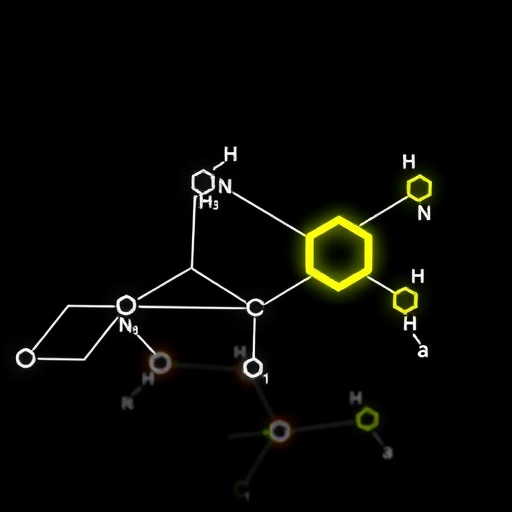In a groundbreaking development at the intersection of photochemistry and asymmetric catalysis, researchers have unveiled new insights into the triplet state reactivity of iminium ions, significantly advancing the field of organocatalytic asymmetric [2 + 2] photocycloadditions. This pioneering study, led by Corti, Simionato, Rizzo, and colleagues, delves deeply into the mechanistic underpinnings and synthetic potential of excited-state iminium ion intermediates, setting the stage for innovative strategies in enantioselective photochemical synthesis.
At the heart of this research lies an exploration of iminium ions—key intermediates traditionally known for their role in enamine and iminium catalysis—now being investigated under the lens of triplet excited state chemistry. By harnessing visible-light activation, the team demonstrates how these electrophilic species, upon intersystem crossing from singlet to triplet states, mediate asymmetric cycloaddition reactions with exceptional stereoinduction. This conceptual leap elegantly bridges classical organocatalysis with modern photochemical paradigms, marking a paradigm shift in the design of photocatalytic asymmetric processes.
Traditional [2 + 2] photocycloadditions, long recognized for their ability to construct cyclobutane motifs, often face challenges regarding regio- and stereocontrol, especially under catalytic conditions. The novel approach reported here circumvents these hurdles by employing chiral organocatalysts capable of engaging substrates via iminium ion formation and subsequent triplet excitation. The resulting triplet iminium intermediate undergoes regio- and stereoselective intermolecular cycloadditions with alkenes, forging cyclobutane frameworks in a manner that is both highly efficient and enantioselective.
Critically, the team’s mechanistic investigations revealed that after photoexcitation, the iminium ion undergoes spin inversion, accessing a reactive triplet state with enhanced lifetimes and unique electronic configurations conducive to selective cycloaddition pathways. Time-resolved spectroscopic studies corroborated the formation and involvement of these long-lived triplet state species, a finding that contrasts starkly with the behavior of typical singlet-state catalytic intermediates. This fundamental insight not only expands the photochemical toolbox but also provides compelling evidence for the feasibility of excited-state organocatalysis operating beyond singlet manifolds.
The synthetic utility of this discovery is underscored by a broad substrate scope demonstrated within the study. Various α,β-unsaturated aldehydes and ketones were converted smoothly into their corresponding iminium ions, which upon visible-light irradiation and chiral organocatalysis, yielded enantioenriched cyclobutanes with impressive diastereo- and enantioselectivity. This versatility underscores the robustness of the catalytic system, highlighting its potential to inspire new methodologies for complex molecule synthesis, including natural product frameworks and pharmacologically relevant scaffolds.
Furthermore, the strategic merging of photochemistry with organocatalysis circumvented the need for traditional transition metal photocatalysts, thereby addressing concerns related to metal contamination and environmental footprint. This metal-free approach aligns well with the principles of green chemistry, offering a more sustainable and cost-effective avenue for asymmetric synthesis.
The researchers also conducted thorough computational studies, employing density functional theory (DFT) and time-dependent DFT (TD-DFT) calculations to elucidate the electronic properties and reactive conformations of the triplet iminium intermediates. These theoretical insights provided a molecular-level rationale for the observed enantioselectivities and regioselectivities, confirming that the chiral environment induced by the organocatalyst steers the photocycloaddition pathway along a highly selective reaction coordinate.
Notably, the study’s innovation stems from a deep understanding of the excited-state dynamics of iminium ions, an area previously underexplored due to the transient nature of such species and the inherent challenges in their spectroscopic characterization. By combining cutting-edge photophysical techniques with rigorous synthetic experimentation, the authors have laid the groundwork for future endeavors targeting excited-state organocatalysts beyond iminium ions.
The implications of this work extend far beyond the immediate synthetic applications. By demonstrating that iminium ions can access reactive triplet states conducive to catalysis, new avenues may open in the design of photoresponsive organocatalysts with tunable electronic properties. Moreover, the principles underlying this triplet state reactivity may inspire analogous strategies in other challenging asymmetric transformations, leveraging excited-state catalysis to unlock previously inaccessible chemical spaces.
This milestone achievement comes at a time when the quest for enantioselective photochemical methodologies is intensifying, driven by both academic curiosity and industrial demand for stereodefined molecular architectures. The ability to harness visible light to trigger highly selective cycloadditions without heavy metals or harsh conditions resonates deeply with modern synthetic priorities, emphasizing efficiency, selectivity, and sustainability.
In conclusion, the research conducted by Corti and colleagues represents a transformative contribution to the field of organocatalytic photochemistry. By elucidating the triplet state behavior of iminium ions and their role in asymmetric [2 + 2] photocycloadditions, it charts a compelling path forward for the integration of light-driven processes in asymmetric synthesis. This work not only enriches our fundamental understanding of excited-state organocatalysts but also paves the way for novel synthetic methodologies that could revolutionize the preparation of complex, enantiomerically pure molecules.
As the scientific community digests these findings, future explorations may involve expanding the catalytic scope, probing other excited-state intermediates, and developing related photochemical reactions with broader substrate compatibility. The intersection of light and chiral organocatalysis promises to yield a treasure trove of synthetic innovations, with this study standing as a beacon guiding those efforts.
Thus, the discovery of triplet state reactivity in iminium ion organocatalysts is poised to become a linchpin in the ongoing evolution of asymmetric photocatalysis. It exemplifies how a nuanced understanding of excited-state chemistry can unlock unprecedented reactivity and selectivity, presenting chemists with powerful new tools for molecular construction in the era of sustainable and precision synthesis.
Subject of Research: Triplet state reactivity of iminium ions in organocatalytic asymmetric [2 + 2] photocycloadditions.
Article Title: Triplet state reactivity of iminium ions in organocatalytic asymmetric [2 + 2] photocycloadditions.
Article References:
Corti, V., Simionato, G., Rizzo, L. et al. Triplet state reactivity of iminium ions in organocatalytic asymmetric [2 + 2] photocycloadditions. Nat. Chem. (2025). https://doi.org/10.1038/s41557-025-01960-3
Image Credits: AI Generated
Tags: asymmetric photochemical synthesischiral organocatalystscyclobutane synthesisenantioselective reactionsiminium ion reactivityinnovative photocatalytic strategiesmechanistic insights in photochemistryorganocatalytic photocycloadditionsregio- and stereocontrol challengestriplet excited state intermediatestriplet state chemistryvisible light activation





